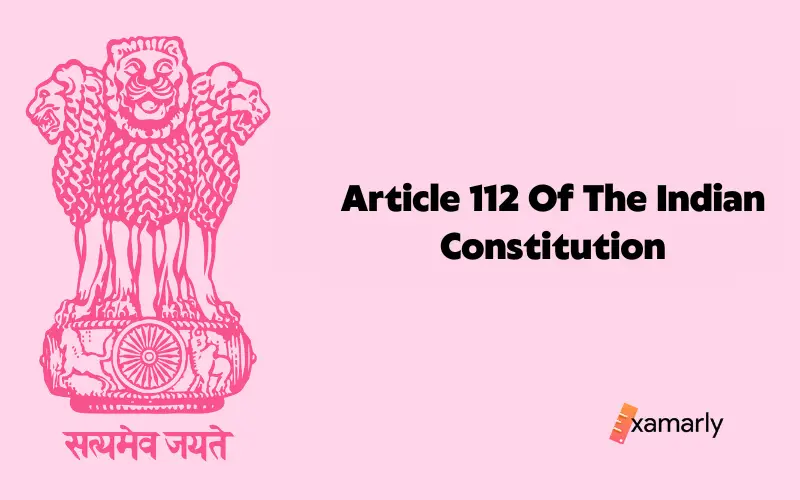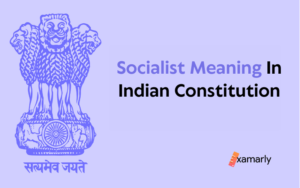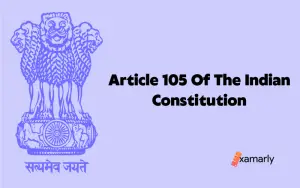Overview
Article 112 of the Indian Constitution talks about the financial aspects of the country. It lays down the measures to keep a check and balance on the prominent funds of the Indian Government.
This article will embody everything you need to know about the financial checks and balances of the country and also about the Consolidated Fund Of India.
Before digging deep into Article 112 of the Indian Constitution, let us know more about the Consolidated Fund Of India as it is a pivotal aspect of this Article.
What is the Consolidated Fund Of India?
The Consolidated Fund Of India is one of the most important government accounts. This fund is constituted of all the funds that are received by the government of India and all the expenses that are done by the Government of India.
Let us now move towards Article 112 of the Indian Constitution and conquer all the concepts quoted in the Constitution.
We will understand the Article in detail by analyzing each and every clause and sub-clause of the Article.
Article 112 Of The Indian Constitution – In Detail
Clause 1 – As it is & Explained
“112. Annual financial statement
(1) The President shall in respect of every financial year cause to be laid before both the Houses of Parliament a statement of the estimated receipts and expenditure of the Government of India for that year, in this Part referred to as the annual financial statement”
Clause 1 of Article 112 of the Indian constitution says that The President is lawfully obliged to present a statement of estimated receipts before both the Houses of Parliament (that is the Lok Sabha and the Rajya Sabha) after the end of every financial year.
The statement will consist of all the expenses that the government of India has made in the past financial year. This statement is referred to as the annual financial statement in this part of the constitution.
Related – Article 110 Of The Indian Constitution
Clause 2 – As it is & Explained
“(2) The estimates of expenditure embodied in the annual financial statement shall show separately
(a) the sums required to meet expenditure described by the Condition as expenditure charged upon the Consolidated Fund of India; and
(b) the sums required to meet other expenditures proposed to be made from the Consolidated Fund of India and shall distinguish expenditure on revenue account from other expenditure”
The second clause is further divided into two sub-clauses. The second clause talks about all the estimations that have to be shown in the statement separately to prevent any kind of discrepancy.
The different estimations that have to be shown separately are defined in sub-clauses (a) and (b).
(a) The sums that are required to make all the expenses as described by the condition that says how much money has to go out of the Consolidated Fund of India.
(b) The overall summation of the expenses that are planned for other important projects or scenarios. There has to be a distinction between the expenditure on revenue over other expenditures.
Clause 3 – As it is & Explained
“(3) The following expenditure shall be expenditure charged on the Consolidated Fund of India
(a) the emoluments and allowances of the President and other expenditure relating to his office;
(b) the salaries and allowances of the Chairman and the Deputy Chairman of the Council of States and the Speaker and the Deputy Speaker of the House of the People;
(c) debt charges for which the Government of India is liable including interest, sinking fund charges and redemption charges, and other expenditure relating to the raising of loans and the service and redemption of debt;
(d)
(i) the salaries, allowances and pensions payable to or in respect of Judges of the Supreme Court,
(ii) the pensions payable to or in respect of Judges of the Federal Court,
(iii) the pensions payable to or in respect of Judges of any High Court which exercises jurisdiction in relation to any area included in the territory of India or which at any time before the commencement of this Constitution exercises jurisdiction in relation to any area included in a Governors Province of the Dominion of India;
(e) the salary, allowances and pension payable to or in respect of the Comptroller and Auditor General of India;
(f) any sums required to satisfy any judgment, decree or award of any court or arbitral tribunal;
(g) any other expenditure declared by this Constitution or by Parliament by law to be so charged”
The third clause of Article 112 of the Indian Constitution talks about all the expenses that are to be paid from the Consolidated Fund of India. These expenses are mentioned in the sub-clauses mentioned below.
(a) The salary of the President, the allowances that he is entitled to receive, and all the expenses that are related to his office.
(b) The salaries of the Chairman and the Deputy Chairman of the Rajya Sabha and the salaries of The Speaker and The Deputy Speaker of the Lok Sabha.
(c) All the debts that the government of India has taken and also the interest. It also includes the redemption charges, the sinking funds, and other expenditures relevant to the loans raised and the services.
(d) The pensions, allowances, and salaries of all the Judges of the Supreme Court. The pensions that are to be paid to the Judges of the Federal Court.
It also included the pension that is to be paid to the Judges of such High Courts that fall under India territory or if they were under Indian Territory before the commencement of the Indian Constitution and exercise jurisdiction with respect to any geographical area that falls under Governors Province of the Dominion of India.
(e) The salary, allowances, and pensions that are to be paid to the Comptroller and Auditor General of India.
(f) The sums that are required to comply with any judgment, decree, or award of any court or arbitral tribunal.
(g) any charges that are defined by the Constitution or the Parliament.
Summing Up
All we can conclude from this article is that Article 112 of the Indian Constitution is one of the most important Articles in the Indian Constitution as it talks about the Consolidated Fund Of India and also it reflects on the provisions for the salaries and compensation of all the monetary transaction of the Indian Government and those officials who are responsible for taking crucial decisions of the country.
It also talks about the additional expenditures that the government makes on yearly basis. The appropriation of money and the withdrawal of money are also some of the important aspects that are covered by Article 112 of the Indian Constitution.
FAQs
Are Consolidated and Contingency Fund Of India the Same?
No, they both are different financial reserves for India but both belong to the government of India.
From where do the highest officials like President, The Speaker, among others get their salaries?
The Highest Officials get their salaries from the Consolidated Fund Of India.
How many types of estimations are there in an annual financial statement that have to be reflected separately?
There are two types of estimations that have to be shown separately. They are charged estimations and voted estimations.






